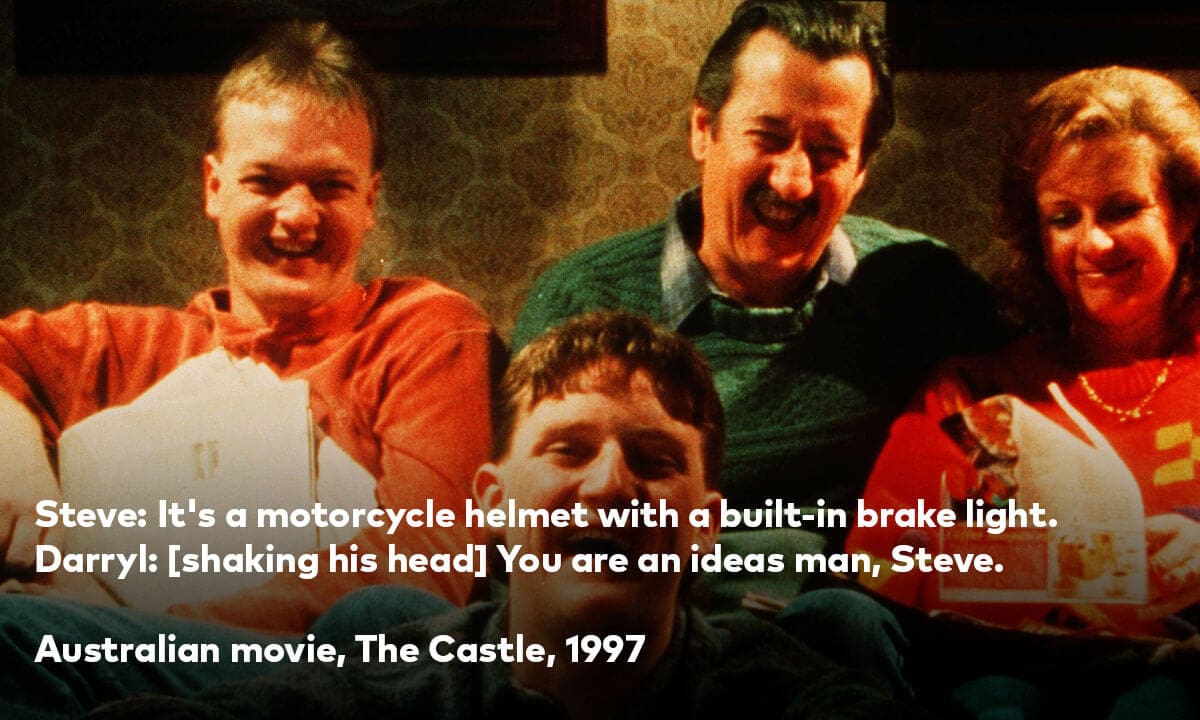Dale: [narration] Steve is also an ideas man. That’s why Dad calls him the Ideas Man. He has lots of ideas.
Steve: It’s a motorcycle helmet with a built-in brake light.
Darryl: [shaking his head] You are an ideas man, Steve.
Australian movie, The Castle, 1997
I’m not a fan of wrapping up my sense of self into labeled boxes, especially ones that are a little misunderstood, but hey, there’s a gentle breeze so let’s throw caution to it. My names Neil and I’m a creative.
It’s not something I’ve ever analysed but I prefer using the right side of my brain than the left. I suspect it’s why my school grades rarely went above C and ‘Neil could do better if he applied himself’ was a regular feature of my school report. The school system prepares us for life as a grown up and, as such, values logic and structure over creative expression. Academic performance can be measured and quantified. Good ideas and school book doodles can’t.
There is some light at the end of the tunnel for us creative types though. Lets hope it’s not a train.
The times they are a changin’
Indeed, there is a shift afoot. Businesses are starting to recognise the importance of innovation and innovation is intrinsically tied to creativity – one cannot exist without the other. True innovation comes from the implementation of valuable creative thinking.
In December 2015 Malcolm Turnbull launched the Australian Governments National Innovation and Science Agenda, with the aim of tapping into an ‘Ideas Boom’. In June 2016 the head of the Commonwealth Bank, Ian Narev, said “If we don’t innovate we’re toast”. There’s a long way to go but it seems that businesses, large and small, can see the value in thinking outside the box. In a rapidly changing world your business has to be light on it’s feet and be able to spin on a coin. Adapting to the change that’s going on around us and innovating within this change is critical to a businesses future success.
If innovation, and in turn creativity, is to form a part of Australian businesses future plans then it can only work if there’s a good understanding of what a creative approach to business is and how your business can benefit. Boiling it down, how logic and creativity can work together.
Misconceptions about creativity
Creative doesn’t necessarily equal artistic. It’s a common misconception. Most creative people don’t own an easel. Nor is creativity some pot induced mystical voodoo limited to the music and arts sector. Creative people can be found in science, architecture, engineering and all professions that require new solutions to problems. The inventor of the Dyson vacuum cleaner, James Dyson, said that innovation comes from finding something that pisses you off and then setting out to fix it.
 With his bike helmet brake light, Steve from legendary Australian movie, The Castle, was an innovator and a true creative. Back then known as ‘an ideas man’. Lumos have taken Steves idea and run with it. Hire that man!
With his bike helmet brake light, Steve from legendary Australian movie, The Castle, was an innovator and a true creative. Back then known as ‘an ideas man’. Lumos have taken Steves idea and run with it. Hire that man!
 Ears to the ground
Ears to the ground
A few things need to happen before a business can truly innovate. A little cultural shift if you like.
- Businesses need a good understanding of who they are, where they sit in the competitive landscape and, importantly, where things are going
- There is a need to balance what’s been successful in the past with what’s going to be successful in the future. Businesses can’t be too precious about what’s gone before
- Keep an open mind. Your way forward is out there and it might not be the most obvious direction. Which leads to…….
- If a business is to be more creative and innovative then staying open to new ideas is critical. Encourage staff to speak up and get involved with the future direction. You’ll be surprised at what you’ll find
- Unless you’re a fly by the seat of your pants type organisation you’ll need to have some idea of how you’re going to execute an idea. This is where left brain meets right brain. Feasibility studies, proof of concept and thorough business planning will help turn the creative ideas into innovative strategies
- New ideas often fail. It’s why many organisations don’t like rocking the boat. A good idea however is a good idea and if something hasn’t worked as planned then it’s important to reflect and learn. Of course it’s equally important to reflect and learn as well if the idea has been an off the chart success
Where to from here?
There needs to be a cultural shift within Australian business. A willingness to take risks, listen to new ideas and act upon them before the ideas will actually boom!
Time will tell whether the ‘ideas boom’ is a erm, good idea.
 Ears to the ground
Ears to the ground